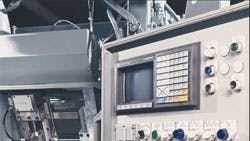Constant motion improvement
Machine tool manufacturers constantly add capabilities to their machines, including profitably making parts with complex machine tools in batches of one, increasing cutting speeds from a few inches per minute to 1,000 ipm, accuracy in millionths of an inch and many more.
One reason these expanding capabilities are possible centers around the controllability, response, speed range, and dynamics of the chosen actuator. It is these motion systems that turn electrical power into machine motion.
One of the technologies helping motion systems engineers to meet these demands is digital control technology. Digital drives are commonplace. They help motors run more efficiently and effectively, and provide diagnostic information that was previously difficult to gain.
Digital technology has changed the computer numerical control (CNC). It has gone from a proprietary, specialized computing device to an industrial personal computer. It does more than tell several axes to move in X, Y, or Z directions at so many inches per second. It executes many tasks simultaneously, such as gathering data on machine tool condition and process operations, displaying these data in chart or graph formats, and translating flow-chart instructions into machine executable code.
Digital technology has also altered the way motion devices send data and instructions. Digital networks are replacing the traditional ±10-V analog signal in drive and motor systems that interface with machine tools. This enables engineers to gain full benefit from the features of digital drives. It also gives engineers the flexibility to arrange machine tools in the configuration that best meets a process’s needs, whether that is centralized or distributed control. The latest trend in the machine tool industry is towards distributed control, where the control components are placed as close as possible to the device being controlled. Distributing I/O, motion control, and PLCs significantly reduces the main-control cabinet volume and wiring.
The machine tool industry is increasingly incorporating linear motors as well as rotary motors into their machines. The benefits of few components that will be subject to wear and the possibility of eliminating cooling requirements makes these motors attractive. And their performance is equivalent to rotary motors — speeds to 200 m/min, position resolutions to 0.01 mm. The types of machines that are using these motors include textile, packaging, thermoforming, laser, water-jet cutting, and high-speed machining centers.
Thus, as customers demand more capable products from the machine tool industry, they in turn demand constant innovations in the capabilities of the actuation devices. The articles in the following machine tool industry report discuss some of the changes and developments as motion system engineers continuously search for ways to improve controllability, response, and speed in the actuation devices that control tool and workpiece motion.
